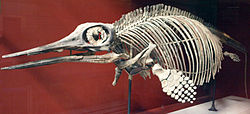| Ophthalmosaurids Temporal range: Middle Jurassic-Late Cretaceous,
| |
|---|---|

| |
| Composite skeleton (NHMUK PV R3702, R3893, R4124) of Ophthalmosaurus icenicus at the Natural History Museum, London | |
| Scientific classification | |
| Domain: | Eukaryota |
| Kingdom: | Animalia |
| Phylum: | Chordata |
| Class: | Reptilia |
| Order: | †Ichthyosauria |
| Clade: | †Baracromia |
| Family: | †Ophthalmosauridae Baur, 1887 |
| Subgroups | |
| |
| Synonyms | |
| |
Ophthalmosauridae is an extinct family of thunnosaur ichthyosaurs from the Middle Jurassic to the early Late Cretaceous (Bajocian - Cenomanian) worldwide.[1] Almost all ichthyosaurs from the Middle Jurassic onwards belong to the family, until the extinction of ichthyosaurs in the early Late Cretaceous. Ophthalmosaurids appeared worldwide during early Bajocian, subsequent to the disappearance of most other ichthyosaur lineages after the end of the Toarcian.[2] Currently, the oldest known ophthalmosaurids is Mollesaurus from the early Bajocian of Argentina,[3] as well as indeterminate remains of the same age from Luxembourg and Canada.[2] Named by George H. Baur, in 1887, the family contains the basal taxa like Ophthalmosaurus.[1] Appleby (1956) named the taxon Ophthalmosauria which was followed by some authors,[4][5] but these two names are often treated as synonyms; Ophthalmosauridae has the priority over Ophthalmosauria.[1] However, some researchers argue that Ophthalmosauridae should be restricted to the group typically referred to as Ophthalmosaurinae, with classic Platypterygiinae instead being referred to as Undorosauridae or Brachypterygiidae and Ophthalmosauria being used to unite these two groups.[6][7]
- ^ a b c Fischer, V.; Masure, E.; Arkhangelsky, M.S.; Godefroit, P. (2011). "A new Barremian (Early Cretaceous) ichthyosaur from western Russia". Journal of Vertebrate Paleontology. 31 (5): 1010–1025. Bibcode:2011JVPal..31.1010F. doi:10.1080/02724634.2011.595464. hdl:2268/92828. S2CID 86036325.
- ^ a b Fischer, Valentin; Weis, Robert; Thuy, Ben (2021-02-22). "Refining the marine reptile turnover at the Early–Middle Jurassic transition". PeerJ. 9: e10647. doi:10.7717/peerj.10647. ISSN 2167-8359. PMC 7906043. PMID 33665003.
- ^ Marta S. Fernández (1999). "A new ichthyosaur from the Los Molles Formation (Early Bajocian), Neuquen Basin, Argentina". Journal of Paleontology. 73 (4): 677–681. Bibcode:1999JPal...73..677F. doi:10.1017/S0022336000032492. JSTOR 1306766. S2CID 130751356.
- ^ Ryosuke Motani (1999). "Phylogeny of the Ichthyopterygia" (PDF). Journal of Vertebrate Paleontology. 19 (3): 472–495. Bibcode:1999JVPal..19..473M. doi:10.1080/02724634.1999.10011160. Archived from the original (PDF) on 2016-03-05. Retrieved 2011-10-19.
- ^ Patrick S. Druckenmiller; Erin E. Maxwell (2010). "A new Lower Cretaceous (lower Albian) ichthyosaur genus from the Clearwater Formation, Alberta, Canada". Canadian Journal of Earth Sciences. 47 (8): 1037–1053. Bibcode:2010CaJES..47.1037D. doi:10.1139/E10-028.[permanent dead link]
- ^ Zverkov, N. G.; Efimov, V. M. (2019). "Revision of Undorosaurus, a mysterious Late Jurassic ichthyosaur of the Boreal Realm". Journal of Systematic Palaeontology. 17 (14): 963–993. Bibcode:2019JSPal..17.1183Z. doi:10.1080/14772019.2018.1515793. S2CID 91912834.
- ^ Cortés, D; Maxwell, E. E.; Larsson, H. C. E. (2021). "Re-appearance of hypercarnivore ichthyosaurs in the Cretaceous with differentiated dentition: Revision of "Platypterygius" sachicarum (Reptilia: Ichthyosauria, Ophthalmosauridae) from Colombia". Journal of Systematic Palaeontology. 19 (14): 969–1002. Bibcode:2021JSPal..19..969C. doi:10.1080/14772019.2021.1989507. S2CID 244512087.